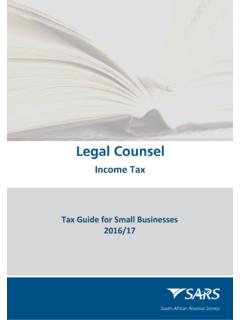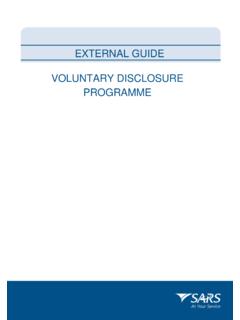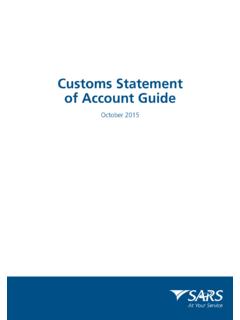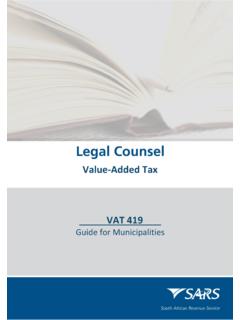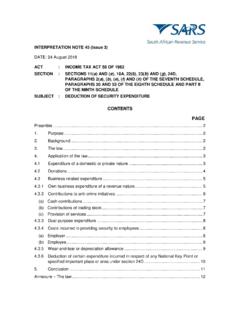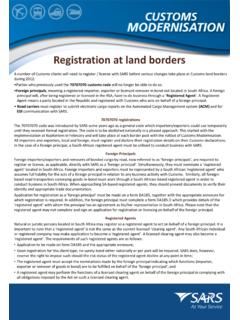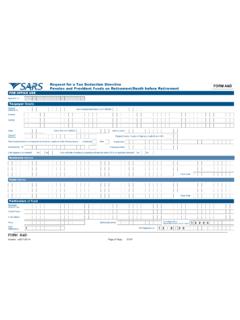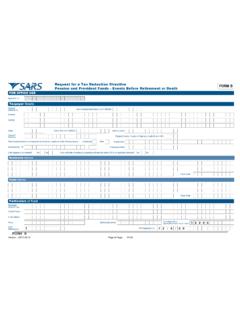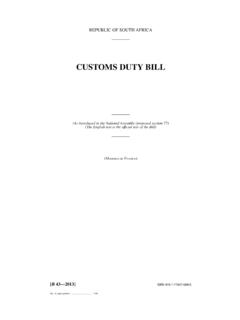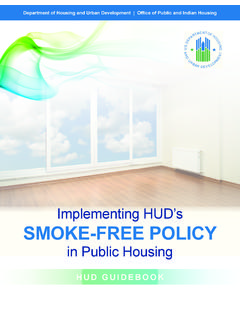Transcription of This guide is a general guide concerning the application ...
1 Value-Added Tax VAT 409 guide for Fixed property and Construction for Vendors Issue 6 VAT 409 guide for Fixed property and Construction Preface i Preface This guide is a general guide concerning the application of the VAT Act in connection with fixed property and construction transactions in South Africa. Although fairly comprehensive, the guide does not deal with all the legal detail associated with VAT and is not intended for legal reference. Technical and legal terminology has also been avoided wherever possible. For details in respect of the general operation of VAT, see the VAT 404 guide for Vendors which is available on the South African Revenue Service (SARS) website ( ). All references to the VAT Act or the Act are to the Value-Added Tax Act 89 of 1991, and references to sections are to sections of the VAT Act, unless the context otherwise indicates.
2 Similarly, all references to TA Act are to the Tax Administration Act 28 of 2011. The terms Republic , South Africa or the abbreviation RSA , are used interchangeably in this document as a reference to the sovereign territory of the Republic of South Africa, as set out in the definition of Republic in section 1(1) of the VAT Act. The terms Commissioner and Minister refer to the Commissioner for SARS and the Minister of Finance respectively, unless otherwise indicated. A number of specific terms used throughout this guide are defined in the VAT Act. These terms and others are listed in the Glossary in a simplified form to make the guide more user-friendly. The information in this guide is based on the VAT and Tax Administration legislation (as amended) as at the time of publishing and includes the amendments contained in the Taxation Laws Amendment Act 34 of 2019, the Rates and Monetary Amounts and Amendment of Revenue Laws Act 32 of 2019 and the Tax Administration Amendment Act 33 of 2019, promulgated on 15 January 2020 in Government Gazette (GG) 42951, 42950 and 42952 respectively.
3 The VAT rate was increased from 14% to 15% with effect from 1 April 2018. Although rate specific rules apply to certain fixed property transactions, the examples in this guide are not affected by, and do not illustrate these rules. For information on how the VAT rate increase affects specific fixed property transactions, see Frequently Asked Questions (FAQs): Increase in the VAT rate from 1 April 2018 on the SARS website. The information in this guide is issued for guidance only. This guide is not an official publication as defined in section 1 of the TA Act and accordingly does not create a practice generally prevailing under section 5 of that Act. It is also not a binding general ruling under section 89 of Chapter 7 of the TA Act or a ruling under section 41B of the VAT Act unless otherwise indicated. The previous edition of this guide has been withdrawn with effect from 11 December 2020.
4 There are various other guides available on the SARS website which may be referred to for more information relating to the specific VAT topics. See the VAT 404 guide for Vendors for a list of the various guides published. All guides, interpretation notes, binging general rulings, forms, returns and tables referred to in this Note are available on the SARS website. For more information, you may visit the SARS website at ; contact your local SARS branch; VAT 409 guide for Fixed property and Construction Preface ii contact your own tax advisors contact the SARS National Call Centre if calling locally, contact the SARS National Call Centre on 0800 00 7277; if calling from abroad, contact the SARS National Call Centre on +27 11 602 2093. Comments regarding this guide may be emailed to Prepared by Leveraged Legal Products SOUTH AFRICAN REVENUE SERVICE Date of 1st issue : September 1991 Date of 2nd issue : 9 December 2008 Date of 3rd issue : 31 March 2011 Date of 4th issue : 26 March 2013 Date of 5th issue : 27 September 2016 Date of 6th issue : 11 December 2020 VAT 409 guide for Fixed property and Construction Contents iii Contents Preface.
5 I Chapter 1 Introduction .. 1 Focus of the 1 Scope of 1 Approach of the guide .. 2 Chapter 2 Definitions and concepts .. 3 Enterprise .. 3 Continuously or regularly .. 3 Commercial accommodation .. 5 Non-enterprise activities (exempt and out of scope supplies) .. 5 Registration .. 6 Goods, fixed property and second-hand goods .. 7 Services .. 8 Supplies .. 9 Output tax .. 11 Input tax .. 11 Going concerns .. 15 Commercial accommodation and domestic goods and services .. 16 Person .. 16 Agency .. 17 Chapter 3 Interaction between value-added tax and other indirect taxes .. 22 Introduction .. 22 Value-added tax vs transfer duty .. 22 Value-added tax and securities transfer tax .. 24 Contract prices .. 24 Chapter 4 Accounting for value-added 26 Introduction .. 26 Tax invoices .. 26 Agency .. 27 Time of supply .. 28 Value of supply .. 30 general rule .. 30 Connected persons.
6 30 Commercial accommodation .. 31 Chapter 5 Adjustments .. 32 Introduction .. 32 Irrecoverable debts .. 32 Debit and credit notes .. 33 Change in use or application .. 35 general .. 35 Change in use from taxable to private or exempt purposes .. 35 Decrease in extent of taxable use of capital goods or services .. 36 Change in use from non-taxable to taxable purposes .. 37 Increase in extent of taxable use or application of capital goods or services .. 37 Subsequent sale or disposal of goods or services partly applied for taxable supplies .. 38 Change in use upon acquisition of a going concern .. 39 VAT 409 guide for Fixed property and Construction Contents iv Chapter 6 Construction .. 41 Introduction .. 41 Relationship between landowner and contractor .. 41 Landowner contracts only with main contractor .. 42 Landowner contracts directly with various contractors .. 42 Construction services.
7 43 Pre-tender stage .. 43 Contract stage .. 45 Tax invoices, debit notes and credit notes .. 47 Tax invoices .. 47 Debit and credit notes .. 48 Professional 48 Chapter 7 Developers and speculators .. 50 Registration .. 50 Input tax .. 50 Output tax .. 50 Advertising or quoting prices .. 52 Land reform and land restitution .. 53 Temporary rental of units (dwellings) .. 54 Sale of a share or member s interest .. 56 Fractional ownership .. 57 Chapter 8 Rental pools .. 59 Introduction .. 59 What is a rental pool scheme? .. 59 Description of a rental pool 59 Functions of a rental pool .. 60 Participation in a rental pool .. 60 Registration .. 60 Accounting for value-added tax .. 61 general administrative issues .. 61 Supplies of commercial accommodation .. 61 Charges for management, administration and other supplies .. 62 Supply of units and changes in use .. 64 (a) Units acquired from the developer (vendor).
8 64 (b) Units acquired from a person other than the developer .. 64 (c) application of units in the rental pool .. 65 (d) Withdrawal of units from the rental 66 (e) Cessation of the rental pool .. 67 (f) Personal use of units .. 67 (g) Rental distribution to owners .. 67 Chapter 9 Miscellaneous issues .. 68 Introduction .. 68 Bare dominium and usufruct .. 68 Employee 68 Expropriation .. 68 Right of occupation (life rights) .. 69 Servitudes .. 69 Levy funds .. 69 Leasehold improvements .. 69 Judgment of the Supreme Court of Appeal on the Respublica case .. 72 VAT 409 guide for Fixed property and Construction Contents v Factual 72 Principles enunciated by the Supreme Court of Appeal in the Respublica case .. 72 Supreme Court of Appeal decision .. 72 Glossary .. 73 Contact details .. 80 VAT 409 guide for Fixed property and Construction Chapter 1 1 Chapter 1 Introduction Focus of the guide The fixed property industry consists of many role-players, including architects, builders, developers, property speculators, quantity surveyors, engineers, plumbers, electricians, municipalities, public entities, financial institutions, estate agents etc.
9 Although these role-players are mentioned in this guide , the content deals primarily with vendors that are involved in transactions concerning the development, construction and selling of fixed property . Scope of transactions VAT is an indirect tax which is levied on the supply of any goods or services supplied by a vendor in the course or furtherance of any enterprise carried on by that vendor. Goods is defined to include fixed property and any real right in any such fixed property , but excluding any right under a mortgage bond or pledge of any fixed property . The scope of transactions with which this guide is concerned with is therefore those described in the definition of fixed property , which means land (together with improvements affixed thereto); any unit as defined in section 1 of the Sectional Titles Act 95 of 1986; any share in a share block company which confers a right to or interest in the use of immovable property under the Share Blocks Control Act 59 of 1980; in relation to a property time-sharing scheme, any time-sharing interest as defined in section 1 of the property Time-sharing Control Act 75 of 1983; and any real right in any such land, unit, share or time-sharing interest.
10 It will therefore be found that most transactions which have some connection with the acquisition of rights to fixed property (excluding rights under a mortgage bond or pledge of fixed property ) will fall within the ambit of the definition and will be subject to VAT if the supplier is a vendor. Other examples of rights falling within the definition include: Certain rights of use such as usufructs, usus or habitatio Bare dominium rights of ownership Servitudes, encroachments and other encumbrances Exclusive use areas in sectional title developments Rights to minerals or rights to mine for minerals Leases or sub-leases of rights to minerals, or to mine for minerals Although most supplies of fixed property by a vendor will be subject to VAT, there are certain instances when such supplies will not be. In these cases, the transactions will be subject to transfer duty. It is therefore important that vendors are able to distinguish between the different types of supplies to establish whether VAT or transfer duty applies.
